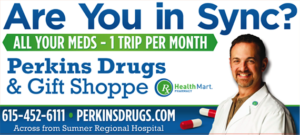Learn how you can make money from med sync
Clinical Performance

One change can save you $15K
In brief:
- The appointment-based model for medication synchronization offers pharmacies an opportunity each month to provide more than medications to customers.
- Adherence coaching, immunizations, MTM and OTC sales can improve service and increase revenue.
- Tracking improved patient adherence also allows a pharmacy to prove its value to providers.

Example of Perkins Drugs’ Sync Rx program ad
When Perkins Drugs began offering medication synchronization in 2013, owner Andrew Finney recognized it would be a game-changer.
“It’s the most exciting change in pharmacy practice that I’ve seen,” Finney said.
With close to 800 patients now on the pharmacy’s Sync Rx program, he has seen the difference the appointment-based model makes in improving adherence and boosting refills, as well as managing the pharmacy’s workflow and making operations more efficient.
Tip: Synchronizing meds of delivery patients can have a dramatic effect. At Perkins Drugs it cut drivers’ mileage by a third, reducing the pharmacy’s delivery costs.
Due to the med sync program, Finney was even able to shorten the pharmacy’s Saturday hours, trimming the schedule by three hours. Instead of being open from 8 a.m. to 4 p.m. on Saturday, Perkins Drugs is now open 9 a.m. to 2 p.m. That one change added $15,000 to the bottom line.
At the same time, the regular contact the appointment-based model provides each month, when a technician calls the patient before refilling prescriptions and when the patient picks up those medications, strengthens a pharmacy’s ability to better know and serve those customers.
Here’s how Perkins Drugs is benefiting from monthly contacts with patients:
- Adherence coaching. When technicians talk to patients each month, they identify which medications customers aren’t taking as prescribed. For example, they may discover that a Spiriva inhaler is lasting a patient two months instead of one. During the sync process technicians can flag prescriptions for the pharmacist to talk with the patient about, such as providing instruction on the proper way to use the inhaler.
- Integrated services. Each month technicians can identify other ways to serve patients, such as discovering whether patients are up to date on immunizations. The pharmacy can schedule campaigns to discuss different services during particular months. In August, Perkins Drugs will begin talking with sync patients about receiving their flu shot through the pharmacy. “By October, we should have everyone done,” Finney said.
- MTM cases. When Perkins Drug identifies an MTM case through Mirixa or Outcomes, it will flag the tray with the medication for that sync patient. A yellow sheet identifies any issue when a patient must talk with the pharmacist.(Note: This year completing comprehensive medication reviews for MTM-eligible patients became a full measure for Star Ratings of Medicare plans. See “What You Need to Know Now About CMRs.”)
- OTC sales. The sync technician at Perkins Drugs asks customers whether they take any vitamins or over-the-counter supplements. If they do, the pharmacy offers to add those products to the monthly delivery of synchronized medications. That’s convenient for the patient and a revenue boost for the pharmacy. “It allows you to capture non-prescription sales,” Finney said.
Tip: Dedicating a technician to your med sync program allows that person to offer more personalized attention to customers during their monthly call in the appointment-based model.
Finney isn’t stopping there with med sync. Armed with data about improved adherence of Perkins Drug patients, he has identified physicians to approach about sending their difficult adherence patients to his pharmacy.
He’s also talking with the local hospital about offering transitional care. Finney can show the adherence rate of patients before and after joining the pharmacy’s sync program. “We’ve got a proven method of getting people adherent on their medications,” he said, and that can reduce costly hospital readmissions.
“When you’re small, you’re nimble, and that’s one of the advantages of independent pharmacies,” Finney said.
With the appointment-based model for med sync, pharmacies have the time and contact with customers each month to offer additional, personalized services beyond prescriptions, providing outstanding service to customers and adding revenue to the pharmacy’s bottom line.
Visit the Medication Synchronization Education Center, sponsored by Health Mart®, for more ideas and resources.
